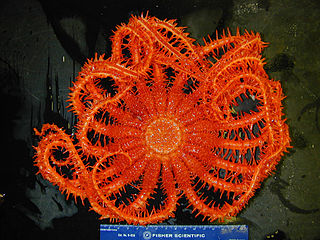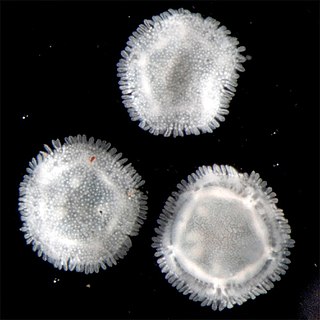
Starfish or sea stars are star-shaped echinoderms belonging to the class Asteroidea. Common usage frequently finds these names being also applied to ophiuroids, which are correctly referred to as brittle stars or basket stars. Starfish are also known as asteroids due to being in the class Asteroidea. About 1,900 species of starfish live on the seabed in all the world's oceans, from warm, tropical zones to frigid, polar regions. They are found from the intertidal zone down to abyssal depths, at 6,000 m (20,000 ft) below the surface.

Brittle stars, serpent stars, or ophiuroids are echinoderms in the class Ophiuroidea, closely related to starfish. They crawl across the sea floor using their flexible arms for locomotion. The ophiuroids generally have five long, slender, whip-like arms which may reach up to 60 cm (24 in) in length on the largest specimens.

Meridiastra mortenseni is a sea star of the family Asterinidae. It is endemic to New Zealand. Described as Patiriella mortenseni in 2002, it is named after T. Mortensen, who recorded it as distinct from Patiriella regularis, the New Zealand common cushion star, in 1925. According to genetic evidence, P. mortenseni was moved from the Patiriella genus to Meridiastra in 2004.

The Forcipulatida are an order of sea stars, containing three families and 49 genera.

The Brisingids are deep-sea-dwelling starfish in the order Brisingida.

The Asterozoa are a subphylum in the phylum Echinodermata. Characteristics include a star-shaped body and radially divergent axes of symmetry. The subphylum includes the class Asteroidea, the class Ophiuroidea, and the extinct order Somasteroidea.

Xyloplax janetae is a Xyloplax of the family Xyloplacidae. It lives on the surface of wood sunken to abyssal depths.
Xyloplax medusiformis is a sea daisy, a member of an unusual group of marine taxa belonging to the phylum Echinodermata. It is found at bathyal depths in waters around New Zealand. It was first described in 1986 by Baker, Rowe and Clark and is the type taxon of the genus Xyloplax. Its generic name derives from the Greek "xylo" meaning wood and its specific name was chosen because its morphology superficially resembles that of a cnidarian medusa.
Xyloplax turnerae is a sea daisy, a member of an unusual group of marine taxa belonging to the phylum Echinodermata. It has been found living on decaying timber in a deep oceanic trench in the Bahamas.

The Freyellidae are a family of deep-sea-dwelling starfish. It is one of two families in the order Brisingida. The majority of species in this family are found in Antarctic waters and near Australia. Other species have been found near New Zealand and the United States.

The Zoroasteridae are one of three families of Asteroidea in the order Forcipulatida. It contains seven living genera and one extinct genus.

Aquilonastra chantalae is a species of starfish from the family Asterinidae. Asterinid sea stars are typically quite small with an often pentagonal-shaped body, though there are exceptions. They are dorsally flattened and have short arms. The body's thin periphery is built up by very small marginal plates. One distinct characteristic of those in this family is the presence of an aboral face shaped by crescent-like plates.
The biological systematics and taxonomy of invertebrates as proposed by Richard C. Brusca and Gary J. Brusca in 2003 is a system of classification of invertebrates, as a way to classify animals without backbones.

Hippasteria muscipula is one of twelve species of deep-sea sea star in the genus Hippasteria, which is in the family Goniasteridae.

Aquilonastra burtoni is a species of small sea star from the family Asterinidae from the Red Sea which has colonised the eastern Mediterranean by Lessepsian migration through the Suez Canal, although the Mediterranean populations are clonal reproducing through fissiparous asexual reproduction. It was originally described in 1840 by the English zoologist and philatelist John Edward Gray.
Ailsa McGown Clark (1926–2014) was a British zoologist, who principally studied echinoderms and was a specialist on asteroidea. She worked at the Natural History Museum for most of her career.
Maureen Elizabeth Downey was an American zoologist who worked for three decades at the Smithsonian National Museum of Natural History. Known as "The Starfish Lady," she was an authority on sea stars and other echinoderms, co-founding the International Echinoderm Conference in 1972. Among her discoveries is Midgardia xandaros, the world's largest starfish.

Dendrogaster is a genus of endoparasitic crustaceans belonging to the family Dendrogastridae. Its habitat depth varies widely, ranging from the intertidal zone to approximately 2,500 m.
Helen Elizabeth Shearburn Rotman was a New Zealand expert on echinoderms, specifically starfish.

Villebrunaster is an extinct genus of starfish-like animal belonging to Asterozoa that lived around 480 million years ago during Early Ordovician Period in modern-day southern France and Morocco. As of 2022, it contains two species, namely V. thorali and V. fezouataensis. V. thorali was described in 1951 and V. fezouataensis was described in 2021. Villebrunaster represents one of the oldest members of asterozoans, and perhaps, according to a description in 2021, the earliest divergent stem-group of Asterozoa.














